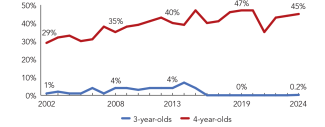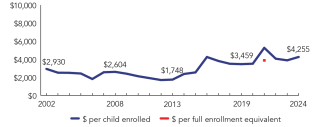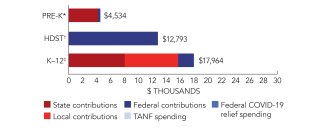
State of Preschool
South Carolina
Access Rankings
Resource Rankings
Total Benchmarks Met
Overview

During the 2023-2024 school year, South Carolina preschool enrolled 27,171 children, an increase of 877 from the prior year. State spending totaled $114,157,651 with an additional $1,466,656 in federal recovery funds to support the program, up $13,581,197 (13%), adjusted for inflation, since last year. State spending per child (including federal recovery funds) equaled $4,255 in 2023-2024, up $375 from 2022-2023, adjusted for inflation. South Carolina met 7 of 10 quality standards benchmarks.
What's New

In the 2024-2025 school year, all Child Early Reading Development and Education Program (CERDEP) teachers will receive training in Language Essentials for Teachers of Reading and Spelling Early Childhood (LETRS EC). All South Carolina Department of Education (SCDE) Early Learning Specialists have taken LETRS EC and are trained as local facilitators. The Early Learning Team will build coaching sessions and modules of learning around the science of reading during the 2024-2025 school year and provide coaching to CERDEP districts to build teacher capacity.
The 2023-2024 school year marks the last year of the three years of ESSER III grant monies that First Steps 4K used for Recruitment and Teacher funding and for the Language and Literacy Boost Pilot program. However, First Steps 4K received state funding to continue the Language & Literacy Enhancement Program and also for Recruitment and Retention of Lead and Instructional Assistants. A recurring budget increase was awarded to First Steps 4K to support higher tuition rates and more slots.
Background
South Carolina funds two preschool programs: the Education Improvement Act Child Development Program (EIA 4K) and the public/private CERDEP. Both programs are delivered in public school settings by the Office of Early Learning & Literacy (OELL). CERDEP is co-administered in private preschool settings by South Carolina First Steps (First Steps 4K), the state’s school readiness initiative.
EIA 4K began in 1984 and is funded as part of a one-cent sales tax supporting public education projects. Eligibility for EIA 4K is prioritized by law for children eligible for FRPL or Medicaid and allows for consideration of children with documented developmental delays. EIA 4K districts may then set their own eligibility criteria from a state-specified list of risk factors. State funding is allocated to districts by OELL using a formula according to the number of kindergarten students who qualify for FRPL in each district. School districts now provide full-day programs, except for a few continuing to offer half-day programs.
CERDEP, originally called the Child Development Education Pilot Program (CDEPP), was created as a pilot program in 2006 in response to Abbeville County School District, et. al. v. South Carolina, a lawsuit initiated by rural school districts regarding school equity funding, the program was codified in 2014 along with the state’s Read to Succeed legislation (Act 284). CERDEP provides full-day preschool to at-risk children.
To monitor quality, OELL conducts visits including an evaluation based on the Early Language and Literacy Classroom Observation (ELLCO) used to provide feedback and support to ensure classrooms are language- and literacy-rich. Some programs receive additional monitoring, which includes a fidelity verification measuring curriculum implementation.
South Carolina Child Early Reading Development and Education Program and EIA/4K
Access
Resources
| Total state pre-K spending | $115,624,307 |
| Local match required? | No |
| State Head Start spending | $0 |
| State spending per child enrolled | $4,255 |
| All reported spending per child enrolled* | $4,534 |

*Pre-K programs may receive additional funds from federal or local sources that are not included in this figure. †Head Start per-child spending includes funding only for 3- and 4-year-olds. ‡K–12 expenditures include capital spending as well as current operating expenditures.
South Carolina Quality Standards Checklist
| Policy | Requirement | Benchmark | Meets Benchmark? |
|---|---|---|---|
For more information about the benchmarks, see the Executive Summary and the Roadmap to State pages. | 7benchmarks met | ||
| Early Learning & Development Standards Benchmark | Comprehensive, aligned, supported, culturally sensitive | Comprehensive, aligned, supported, culturally sensitive | |
| Curriculum Supports Benchmark | Approval process & supports | Approval process & supports | |
| Teacher Degree Benchmark | BA (public); AA (nonpublic) | BA | |
| Teacher Specialized Training Benchmark | ECE | Specializing in pre-K | |
| Assistant Teacher Degree Benchmark | HSD | CDA or equivalent | |
| Staff Professional Development Benchmark | 15 hours/year; PD plans; Coaching | For teachers & assistants: At least 15 hours/year; individual PD plans; coaching | |
| Maximum Class Size Benchmark | 20 (4-year-olds) | 20 or lower | |
| Staff to Child Ratio Benchmark | 1:10 (4-year-olds) | 1:10 or better | |
| Screening & Referral Benchmark | Immunizations, developmental (CERDEP/EIA 4K); Vision, hearing, health & more (First Steps) | Vision, hearing & health screenings; & referral | |
| Continuous Quality Improvement System Benchmark | Structured classroom observations; Data used for program improvement | Structured classroom observations; data used for program improvement | |
